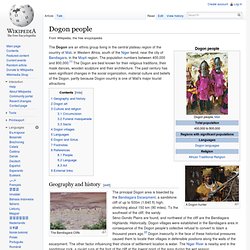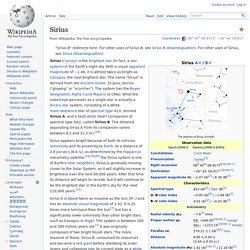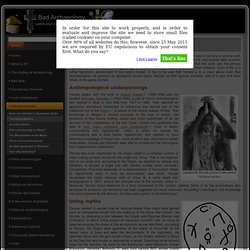

Dogon Tribe. Dogon people. The Dogon are an ethnic group living in the central plateau region of the country of Mali, in Western Africa, south of the Niger bend, near the city of Bandiagara, in the Mopti region.

The population numbers between 400,000 and 800,000.[1] The Dogon are best known for their religious traditions, their mask dances, wooden sculpture and their architecture. The past century has seen significant changes in the social organization, material culture and beliefs of the Dogon, partly because Dogon country is one of Mali's major tourist attractions. A Dogon hunter Geography and history[edit] The Bandiagara Cliffs The principal Dogon area is bisected by the Bandiagara Escarpment, a sandstone cliff of up to 500m (1,640 ft) high, stretching about 150 km (90 miles). Among the Dogon several oral traditions have been recorded as to their origin. Dogon art[edit] Dogon wood sculpture, probably an ancestor figure, 17th-18th century Dogon art is primarily sculpture. Culture and religion[edit] Circumcision[edit]
Sirius. Sirius appears bright because of both its intrinsic luminosity and its proximity to Earth.

At a distance of 2.6 parsecs (8.6 ly), as determined by the Hipparcos astrometry satellite,[5][19][20] the Sirius system is one of Earth's near neighbors. Sirius is gradually moving closer to the Solar System, so it will slightly increase in brightness over the next 60,000 years. After that time its distance will begin to recede, but it will continue to be the brightest star in the Earth's sky for the next 210,000 years.[21] Sirius A is about twice as massive as the Sun (M☉) and has an absolute visual magnitude of 1.42.
It is 25 times more luminous than the Sun[7] but has a significantly lower luminosity than other bright stars such as Canopus or Rigel. Observational history[edit] Sirius, known in ancient Egypt as Sopdet (Greek: Σῶθις Sothis), is recorded in the earliest astronomical records. The indigenous Boorong people of northwestern Victoria named Sirius as Warepil.[42] Kinematics[edit] Robert Temple’s The Sirius Mystery. In 1976, Robert K G Temple (born 1945), an American living in the UK, published what was to become a seminal work of Bad Archaeology, The Sirius Mystery.

A revised edition was published in 1998 with the new subtitle New scientific evidence of alien contact 5,000 years ago. Some have gone so far as to suggest that this book was the primary inspiration for the so-called ‘New Egyptology’ of Graham Hancock, Robert Bauval and their imitators. Even if this is a rather hyperbolic assessment of the book’s impact, it has to be said that Temple is in a class above most Bad Archaeologists: he presents an apparently secure thesis, backed up with rigorous scientific data of a type that most others in the genre eschew.